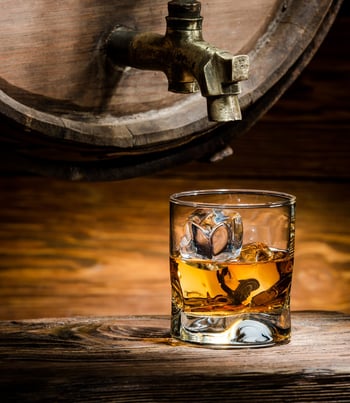What’s the only thing better than a freshly made Manhattan?
A Manhattan that’s been happily snoozing in an oak barrel for a few weeks. 
The novelty and sophisticated flavor of barrel-aged cocktails have proved to be consistently popular with bar patrons. But aging cocktails isn’t the simplest process: You’ve got to prep your barrel, seal the leaks, store it properly, and monitor your mixture’s progress. To succeed, you’ll need a killer drink recipe and a bar staff that’s enthusiastic about experimentation and attentive to detail.
Let’s look at the pros and cons of serving barrel-aged cocktails.
The Pros of Barrel-Aged Cocktails
- Barrel-aged drinks command a price premium. The Rye Bar in Washington, D.C. serves a barrel-aged Manhattan made with Dad’s Hat Pennsylvania rye whiskey, Dolin Rouge vermouth and Byrrh Grand Quinquina. None of these liquors is expensive on its own, but after the cocktail is mellowed for six weeks in a charred bourbon barrel, it sells (and sells well!) for $22.
- Aging really can improve the flavor. When spirits spend time in a wooden barrel, they become smoother and sweeter, with new notes of oak, vanilla and caramel. You have to begin with high-quality spirits, however. “You can’t make a bad cocktail good, but you can make a good cocktail great through barrel-aging," says Blaine Adams, bar program director at Los Angeles’ Barrel and Ashes.
- Serving is simple. Unlike a craft cocktail that requires 10 minutes of measuring and muddling, shaking and straining, barrel-aged cocktails are poured and garnished. Done.
The Cons of Barrel-Aged Cocktails
- There’s always a risk that things will go wrong. Fermentation. Off-flavors. Even experienced bartenders have plenty of stories to tell about mistakes they’ve made while barrel-aging drinks. If you’re working with expensive liquors, a few bad batches can dent your bar’s bottom line. To maximize your chances of success, use only high-proof liquors, avoid syrups and bitters, and don’t add fruit juice or other organic materials.
- You’ll lose about 10 percent of what you put in. Evaporation can’t be avoided. Losing the angel’s share, as bartenders call it, is just part of the aging process.
- Barrels aren’t cheap. The retail price for a 1- to 3-liter charred oak barrel is around $50 to $75 (or more). They can be used more than once, but the oak flavor will diminish and the flavors of the previously aged cocktail will permeate the next one you make. You may get only two or three satisfactory batches per barrel.
- Barrel-aging takes time. "Every time you do a batch, you’ll have to double or triple the length of the aging process,” explains Adams, of Barrel and Ashes. The second batch in a barrel might require three months or more, and the third might take up to a year. But don’t it sit too long! Once the flavors are perfectly balanced, use a vacuum sealer — like the PrimaVac™ line from Hamilton Beach Commercial — to store the aged cocktail and prevent any further oxidation.
Alternatives to Barrel-Aging Cocktails
Maybe your bar doesn’t have the space or the time to experiment with barrel-aging cocktails, but you still want to offer your customers a signature cocktail with unique flavors. One possibility: using a barrel stave or wooden spiral to age your spirits. Slender, charred pieces of oak, cherry or other wood are placed directly in the bottle, imparting flavor without all the fuss.
Another, surprisingly swift way to add complexity to cocktails is with house-made infusions. Use a commercial vacuum chamber sealer to infuse liquor or simple syrups with herbs, fresh fruit, vegetables, even bacon. The result is a cocktail with intriguing, all-natural flavors. Read more in our guide to sous-vide infused cocktails (and get a free eBook).
Have you experimented with barrel aging or cocktail infusions? Tell us about it! We’re always looking for restaurant and bar innovators to feature in this space.


